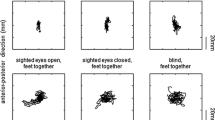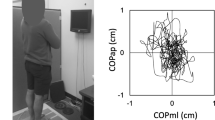Abstract
Visual feedback (VFB) of the resultant centre of pressure (CPRes) is a potentially interesting technique for rehabilitation purposes. However, all past studies have not been unanimous in supporting its utility in a physical therapy program. The present study was therefore undertaken with the main aim of assessing whether insights from postural control without additional feedback could be gained to explain the possible VFB effects. The CPRes displacements of 65 healthy adults were analysed in two conditions (eyes-open and VFB) through various classical parameters (including surface and variances along each medio-lateral and antero-posterior axes) and fractional Brownian motion (fBm) modelling. The results indicate that 69% of the sample were dependent on VFB, i.e. that the surface covered by the CPRes displacements was smaller during VFB than in the eyes-open condition. The comparison of the two subgroups (i.e. those who were dependant on VFB and those who were not) brought out significant differences in many classical and fBm parameters. In addition, the correlation between the degree of VFB dependency and the values measured during the eyes-open condition indicates that the more the subjects are VFB-dependent, the less they lean forward, the smaller the variance and the better the CPRes displacements are controlled over the longest time intervals. By specifying the links between the postural performance in an eyes-open standard condition and the degree of VFB dependency, a number of clues help identify the reasons for which some subjects do not succeed in using this technique, hence explaining the controversy about its use as a rehabilitation tool.




Similar content being viewed by others
References
Berger L, Chuzel M, Buisson G, Rougier P (2005) Undisturbed upright stance control in the elderly: part I: age-related changes in undisturbed upright stance control. J Mot Behav 37(5):348–358
Bonan IV, Colle FM, Guichard JP, Vicaut E, Eisenfisz M, Tran Ba Huy P, Yelnik AP (2004) Reliance on visual information after stroke. Part I: balance on dynamic posturography. Arch Phys Med Rehabil 85:268–273
Bottaro A, Yasutake Y, Nomura T, Casadio M, Morasso P (2008) Bounded stability of the quiet standing posture: an intermittent control model. Hum Mov Sci 27:473–495
Cheng PT, Wang CM, Chung CY, Chen CL (2004) Effects of visual feedback rhythmic weight–shift training on hemiplegic stroke patients. Clin Rehabil 18:747–753
Collins JJ, de Luca CJ (1993) Open-loop and closed-loop control of posture: a random-walk analysis of center of pressure trajectory. Exp Brain Res 95:308–318
Collins JJ, de Luca CJ (1994) Random walking during quiet standing. Phys Rev Lett 73(5):764–767
Collins JJ, de Luca CJ, Burrows A, Lipsitz LA (1995) Age-related changes in open-loop and closed-loop postural control mechanisms. Exp Brain Res 104(3):480–492
di Fabio RP, Badke MB (1990) Extraneous movement associated with hemiplegic postural sway during dynamic goal-directed weight redistribution. Arch Phys Med Rehab 71:265–271
Doyle RJ, Hsiao-Wecksler ET, Ragan BG, Rosengren KS (2007) Generalizability of center of pressure measures of quiet standing. Gait Posture 25(2):166–171
Geiger RA, Allen JB, O’Keefe J, Hicks RR (2001) Balance and mobility following stroke:effects of physical therapy interventions with and without biofeedback/forceplate training. Phys Ther 81:995–1005
Genthon N, Rougier P, Gissot AS, Froger J, Pélissier J, Perennou D (2008) Contribution of each lower limb to upright standing in stroke patients. Stroke 39:1793–1799
Lacour M, Barthelemy J, Borel L, Magnan J, Xerri C, Chays A, Ouaknine M (1997) Sensory strategies in human postural control before and after unilateral neurotomy. Exp Brain Res 115:300–310
Loram ID, Maganaris CN, Lakie M (2005) Human postural sway results from frequent, ballistic bias impulses by soleus and gastrocnemius. J Physiol 564(1):295–311
Mandelbrot BB, van Ness JW (1968) Fractional Brownian motions, fractional noises and applications. SIAM Rev 10:422–437
Peterka RJ (2000) Postural control model interpretation of stabilogram diffusion analysis. Biol Cybern 82:335–343
Riley MA, Wong S, Mitra S, Turvey MT (1997) Common effects of touch and vision on postural parameters. Exp Brain Res 117:165–170
Riley MA, Balasubramaniam R, Mitra S, Turvey MT (1998) Visual influences on center of pressure dynamics in upright posture. Ecol Psychol 10:65–91
Rocchi L, Chiari L, Cappello A (2004) Feature selection of stabilometric parameters based on principal component analysis. Med Biol Eng Comput 42:71–79
Rocchi L, Chiari L, Cappello A, Horak FB (2006) Identification of distinct characteristics of postural sway in Parkinson’s disease. Neurosci Lett 394:140–145
Rougier P (1999a) Influence of visual feedback on successive control mechanisms in upright quiet stance in humans assessed by fractional Brownian motion modelling. Neurosci Lett 266:157–160
Rougier P (1999b) Automatic determination of the transition between successive control mechanisms in upright stance assessed by modelling of the centre of pressure. Arch Physiol Biochem 107:35–42
Rougier P (2003) Visual feedback induces opposite effects on elementary centre of gravity and centre of pressure minus centre of gravity motions in undisturbed upright stance. Clin Biomech 18:341–349
Rougier P (2005) Compatibility of postural behaviors induced by two parameters of visual feedback: time delay and scale display. Exp Brain Res 165:193–202
Rougier PR (2007a) Relative contribution of the pressure variations under the feet and body weight distribution over both legs in the control of upright stance. J Biomech 40(11):2477–2482
Rougier P (2007b) How visual feedback of decomposed movements of the centre of pressure trajectories affects undisturbed postural control of healthy individuals. IEEE Trans Biomed Eng 54(5):813–820
Rougier P, Caron O (2000) Centre of gravity motions and ankle joint stiffness control in upright undisturbed stance modeled through a fractional Brownian motion framework. J Mot Behav 32(4):405–413
Rougier P, Garin M (2006) La réalisation de mouvements de saccades oculaires affecte les stratégies de maintien de l’équilibre. Neurophysiol Clin 36:235–243
Rougier P, Burdet C, Farenc I, Berger L (2001) Backward and forward leaning postures modelled by an fBm framework. Neurosci Res 41(1):41–50
Sackley CM, Lincoln NB (1997) Single blind randomized controlled trial of visual feedback after stroke: effects on stance symmetry and function. Disabil Rehabil 19:536–546
Santos BR, Delisle A, Larivière C, Plamondon A, Imbeau D (2008) Reliability of centre of pressure summary measures of postural steadiness in healthy young adults. Gait Posture 27(3):408–415
Shumway-Cook A, Anson D, Haller S (1988) Postural sway feedback: its effect on re-establishing stance stability in hemiplegic patients. Arch Phys Med Rehab 69:395–400
Simmons RW, Smith K, Erez E, Burke JP, Pozos RE (1998) Balance retraining in a hemiparetic patient using center of gravity biofeedback: a single case study. Percept Mot Skills 87:603–609
Tagaki A, Fujimara E, Suehiro S (1985) A new method of statokinesigram area measurement: application of a statistically calculated ellipse. In: Igarashi M, Black O (eds) Vestibular and visual control on posture and locomotor equilibrium. Karger, Basel, pp 74–79
Walker C, Brouwer BJ, Culham EG (2000) Use of visual feedback in retraining balance following acute stroke. Phys Ther 80:886–895
Winter DA, Prince F, Frank JS, Powell C, Zabjek KF (1996) Unified theory regarding A/P and M/L balance in quiet standing. J Neurophysiol 75:2334–2343
Acknowledgments
The authors are pleased to thank L. Northrup for editing the English text.
Author information
Authors and Affiliations
Corresponding author
Rights and permissions
About this article
Cite this article
Boudrahem, S., Rougier, P.R. Relation between postural control assessment with eyes open and centre of pressure visual feedback effects in healthy individuals. Exp Brain Res 195, 145–152 (2009). https://doi.org/10.1007/s00221-009-1761-1
Received:
Accepted:
Published:
Issue Date:
DOI: https://doi.org/10.1007/s00221-009-1761-1




